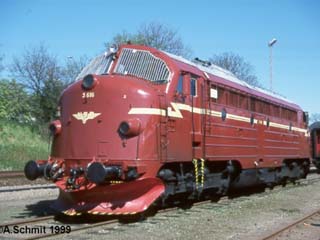
Photo courtesy Armand Schmit © copyright
Armand's Diesellokomotivseite

Photo courtesy Armand Schmit © copyright
Armand's Diesellokomotivseite
Built by Nydquist och Holm AB or NOHAB in Sweden, under license from GM-EMD, and powered by EMD's 16 cylinder 567 cid prime mover; the prototype 'Mv' class were basically a 1700HP US F-type cab unit with a second driving cab at the B or No.2 end. The most notable departure from the otherwise classic American styling was the provision of suitable screw couplers and buffers. A six wheel truck based on that of the EMD 'E unit' with an A1A-A1A wheel arrangement kept axle loads to a level acceptable for European permanent way,
So impressed was the DSB that a production run of 54 virtually identical units with slightly uprated 1950HP engines was delivered, and designated class 'My'; followed by a further delivery of 45 1425HP units classified 'Mx'.
Having trialled diesel hydraulic power on the Oslo - Bergen corridor, the Norwegian State Railways (NSB) found the hydraulic transmission unsuitable for use on the arduous grades between Voss and Geilo. Also in 1954, the NSB began to take delivery of 1750HP EMD-NOHAB units of a Co-Co wheel arrangement. Classified Di3a, these units would become the most reliable locomotives ever to work the Norwegian system.
Between 1958 and 1960, NSB took delivery of an A1A-A1A version built for the Finnish Railways (VR) who had cancelled their order for NOHAB diesels. These visually almost identical units were ideally suited to passenger work with the fastest gear ratio of all EMD-NOHABS enabling a top speed of 143km/h; and a lower starting tractive effort. These 3 units, classified Di3b were unpopular with maintenance crews due to their slightly different trucks and traction motors; though the class outlasted it's more numerous relative due to it's effectiveness as a passenger locomotive.
In 1960 the Hungarian State Railways MÁV, requested worldwide tenders to construct diesel electric locomotives with an output of 1000-1500 kW for mainline duties. Tenders were received from all the major Western European manufacturers, and 2 proprietaries provided demonstrator models. Krauss Maffei sent a 6-axle version of the DB V200 diesel hydraulic; and NOHAB arranged for an NSB Di3 to travel accross Europe.
Both locomotives performed well, but recent bad experiences with hydraulic transmission in Ganz shunters, and an unwillingness to maintain a locomotive containing two prime movers led to MÁV's decision to opt for the NOHAB units which had been very reliably operated in Denmark and Norway for several years.
Classified M61, the first MÁV NOHABS were pressed into service during 1963 to help alleviate the shortage of motive power on the Budapest - Miskoll line. As more units were delivered they worked from Budapest to Vienna, Kurtos and Subotica; eventually covering all non-electrified lines on the Hungarian system.
Resources
General Data
Images
Audio
3D Model
NOHAB & AFB Diesels - Armand's Diesellokomotivseite
Hungarian NOHABS - Galaxy's Railpage
Di3 Photo Archive - Lolke Bijlsma's homepage
| Auran Website | Database | Locomotives | Trainz Website |